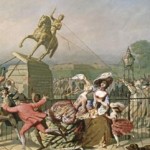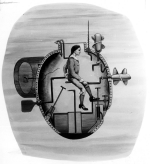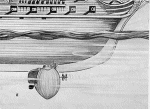Joseph Brodsky, in “Homage to Marcus Aurelius,” describes the “etiquette of equestrian statuary: “…when a horse, for instance, rears up under the rider, it means that the latter died in battle. If all of its four hooves rest on the pediment, that suggests he died in his four-poster.” Up at Riverside Drive and West 106th Street, Karl Bitter’s heroic bronze represents Major General Franz Sigel, U.S. Army, astride his stallion (it is, as the Spanish say, an entire horse), gazing toward the Palisades. The horse’s four feet are firmly planted in the ground. He is going nowhere, as if in protest to his rider’s latest imbecility.
“What was curious about him,” wrote Stephen Douglas Engle, Sigel’s sole biographer, “was not what he did, but his exalted status for what he failed to do.” He was born at Sinheim, in the Grand Duchy of Baden, on November 24, 1824. In 1843, Sigel graduated with honors from the Military School at Carlsruhe, received his lieutenant’s commission, and despite his liberal views served Grand Duke Leopold with distinction until 1847, when he was challenged to a duel over his politics. As an officer, he could not refuse. He fatally wounded his opponent, was placed under arrest, and resigned his commission.
The European rebellions of 1848 are comparable only to the 1968 student revolts throughout Europe and the United States. In Germany, the Forty-Eighters sought German unification under a liberal constitution. Sigel became the revolutionary government’s war minister. When the Prussians invaded to restore the old order, he took the field, lost all three of his battles, and skipped for Switzerland.
In exile, he revealed his true genius: public relations. Sigel’s skills as a self-publicizing journalist and orator transformed him from the man who had lost every battle he had fought into a legendary hero. Meanwhile, he made a living. He even played piano in a sideshow at London’s Crystal Palace. In 1852 he came to New York, where he taught, published a weekly newspaper, and joined the state militia. He also organized German athletic and cultural societies, thus creating and maintaining friendships among German immigrant leaders throughout the major eastern cities, and published articles in German-language newspapers across the country. In 1857, the German-American Institute of St. Louis, Missouri appointed him instructor in mathematics and history.
Throughout his adult life, Sigel was solidly built, weighing about 145 pounds, and roughly 5’7″ tall. In youth, his hair was coal black. He carried himself like a soldier; his gaze was piercing and his handshake firm. Despite an intelligent and sensitive mind, he was terse and humorless. Americans found him stiff, nervous, and unyielding. Yet the man whom West Pointers called “the block of ice” could move and inspire German-speaking audiences. He came to incarnate their hopes for winning honor and advancement in their new country.
On May 4, 1861, he was elected colonel of the Third Missouri; six days later, he helped suppress the attempted secession of Missouri. His first independent command, at the Battle of Carthage, was marked as usual by defeat, but somehow the press coverage presented him well, and he became famous. On August 10, 1861, as a newly minted brigadier general, he commanded a wing of the Federal forces at Wilson’s Creek, contributing to the Union defeat by his inept handling of troops. Indeed, his command was routed by two companies of Louisiana volunteers. Yet again he was widely praised in the press.
Part of this stemmed from media manipulation. He was a master of the exclusive interview and the news leak. His aides hand-delivered his dispatches to reporters so that his version of events got out first. Thus bloomed his career.
When he was passed over for independent field command in December 1861, he offered his resignation in protest. Public support from thousands of immigrants convinced his superiors to decline a resignation they had received with joy. Thus he commanded two divisions at the Battle of Pea Ridge, Arkansas, perhaps his finest hour, where he did not foul up. Friendly newspapers consequently proclaimed him the true genius of the victory, rather than his commander, the quietly competent General Samuel Curtis, and Sigel received his second star on March 21, 1862.
Major General Sigel was transferred to Virginia. His adoring fans lionized him during the train journey from Missouri. One who believed Sigel’s press clippings might think Grant and Lincoln had little to do with the war’s conduct. There were even popular dialect songs:
I’ve come shust now to tells you how
I goes mit regimentals,
To SCHLAUCH dem foes of Liberty,
Like dem old Continentals
Vot fights mit England, long ago
To save de Yankee eagle;
Un now I gets mine sojer clothes,
I’m going to fight mit Sigel.
Chorus:
Yaw! daus is drue, I shpeaks mit you,
I’m going to fight mit Sigel.
Happily, Sigel’s modest performance as a corps commander under Major General John Pope was overlooked after Pope’s debacle at the Second Battle of Manassas in August 1862. His superiors quietly shunted him into insignificant posts where he could do no harm.
But, unsatisfied by mere prestige, Franz Sigel lusted for glory. As the 1864 presidential election approached, he lobbied for a major command. He got the Department of West Virginia, effective February 29, 1864. A staff officer wrote, “The [German] vote must be secured at all hazards. And the sacrifice of West Virginia is a small matter.” Grant soon ordered Sigel to advance upon Staunton, Virginia to cut the Virginia Central Railroad and threaten Lee’s left flank.
Major General John C. Breckinridge, C.S.A., the Confederate commander of the Western Department of Virginia and Sigel’s opposite number, had been appointed to his command only four days earlier. State legislator, Congressman, and United States Senator, Breckinridge had become the youngest Vice President of the United States at thirty-five. At thirty-nine, although a reluctant Presidential nominee, he had run second to Lincoln in the Electoral College. He had not left the Union: the Union had expelled him to the Confederacy by ordering his arrest for his principled opposition to the war. In a moment of anger and frustration, he accepted a general’s commission in the Confederate army. He later called this the greatest mistake of his life.
In the spring of 1864, he was only forty-three years old. He was tall, strikingly attractive, genial, good-humored, hard working, and almost effortlessly competent. Although Breckinridge was not a professional soldier, he learned from experience. He did not make the same mistake twice. Basil Duke, one of his subordinates, wrote that Breckinridge “had unquestionably a remarkable sagacity in all matters pertaining to actual warfare….”
His courage and resolution were superb…Along with his stronger and more virile qualities was an exceeding amiability of temper and an admirable self-control.”
Not the least among his lesser gifts was his magnificent horsemanship: his style was famously smooth and graceful: “General Breckinridge galloped past, riding like a Cid.” Years later, on being called the handsomest man on horseback, a particularly dashing Union cavalryman replied, “You never saw John Breckinridge.”
As Sigel was careless about security, General Robert E. Lee soon learned he would advance into the Shenandoah Valley with some 23,000 Union veterans: good troops, well rested, well supplied. They had served well under other commanders and would again. Against this, Breckinridge commanded some 5,500 Confederate regulars and militia.
Sigel began a leisurely advance on May 1, opposed only by skirmishing Rebel cavalrymen. Though effectively unimpeded, he advanced only sixty-five miles in two weeks. On May 5, he held maneuvers, sending forth a regiment as a skirmish line. Then he forgot about it. At the end of the day, the army counted its casualties: “Killed, none; wounded, none; missing, the 34th Massachusetts Infantry.”
Confederate raiders began plundering Sigel’s supply lines. He continued his advance while pulling his scouts from reconnaissance to escort the wagon trains, thus moving blindly into enemy country. He allowed his forces to be badly strung out over some nineteen miles of muddy road. It is difficult to imagine a mistake that he did not make.
By contrast, Breckinridge’s scouts reported nearly every Union move, sometimes within minutes. The former Vice President had united his forces, making clever use of the railroads to speed his advance. General Lee even authorized him to accept the services of 257 cadets from the renowned Virginia Military Institute, the West Point of the South. The cadets marched 160 miles in four days to reach the front.
On May 14, Sigel’s forces encountered a Confederate cavalry screen—the human equivalent of radar—about eight miles north of New Market, Virginia. As Sigel pressed south into the town, the Rebel horsemen gave ground before him, remaining just out of reach while sending estimates of the Union forces to Breckinridge.
By 6:00 a.m., Breckinridge’s artillery was already on the high ground about a mile south of New Market. Breckinridge feinted with his cavalry against the Union forces, trying to spark a fight, even while marching and counter-marching several of his units just within sight of the enemy to create the illusion of greater numbers. It worked. Sigel disregarded his own intelligence reports, having concluded that Breckinridge must be commanding upwards of 9000 men. Some of Sigel’s subordinates believed there were 20,000 Confederates on the field.
Breckinridge stood atop Shirley’s hill, the high ground south of New Market. He opened his watch, turned to his commanders and said, “It is 11:00 o’clock. I have offered him battle and he declines to advance on us. I shall advance on him.”
Throughout the war, Breckinridge’s basic battle plan never varied, largely because it always worked and his opponents never bothered to study his successes. He used it again at New Market. His cavalry flanked Sigel’s front line, pushing it back, and his infantry pressed the Union troops back into the town. By 12:30 p.m., Breckinridge had taken New Market from Sigel.
At 2:00 p.m., Breckinridge rode forward with his field artillery. Instead of using his guns conventionally, merely to soften up the enemy before the attack, he used them as the most mobile part of his offense, often ahead of his infantry, advancing, firing, and advancing again. This was revolutionary: the infantry were supposed to protect the guns, not the other way around. This too worked. Sigel’s first line fell back in disorder, running through his second line and throwing it into confusion.
Breckinridge handled his outnumbered troops so well that when he began his general advance in mid-afternoon, he would have more troops in combat than Sigel. At this moment, a Union artillery battery blasted a hole in the left center of Breckinridge’s line with grapeshot and canister. His troops were now fully engaged. His only reserve was the cadets. Breckinridge turned to his aide de camp, Major Charles Semple, with tears in his eyes. “Put the boys in, and may God forgive me for the order.”
An aide galloped up to the commandant of cadets with the orders. The cadets cheered. Then, in perfect order, they advanced, closing their ranks under fire as their comrades began dropping. They plugged the gap, fired a volley, and then advanced with the rest of Breckinridge’s line through mud that sucked the shoes from their feet.
Sigel tried to organize a counterattack. In his excitement he began barking orders in German, making his commands incomprehensible. The cadets drove toward a battery. The Union artillerists fired to nearly the last moment, leaving one gun behind. Then the boys were among them, and it was over. Ten cadets died; forty-seven were wounded. Breckinridge rode up, encrusted with mud, and called out, “Well done, men!” One cadet replied, “That’s very nice, general, but where’s the commissary wagon?”
Undaunted, Sigel began yet another attempt to transform military debacle into personal advancement even as he left the field. He began firing reports to the newspapers, describing his retreat as a “retrograde movement” and grossly inflating the size of Breckinridge’s forces. The New York Tribune for May 18, 1864 even printed “SIGEL WHIPS THE REBELS AT NEW MARKET.”
But the feline Union chief of staff, Henry Halleck, had already wired General Grant, “…Sigel is already in full retreat…If you expect anything from him you will be mistaken. He will do nothing but run. He never did anything else.” Halleck then inquired whether General Grant felt the Department of West Virginia needed a new commander. Grant shot back: “BY ALL MEANS…APPOINT…ANYONE ELSE TO THE COMMAND OF WEST VIRGINIA.”
On May 19, 1864, four days after New Market, the day after the New York Tribune had printed its headline, Sigel was relieved of command. He would never command troops again and resigned his commission in 1865.
For the rest of his long life, he would edit and publish German weeklies in Baltimore and then New York. In 1869, the Republicans nominated him for Secretary of State of the State of New York. He campaigned against prohibition, arguing that lager was God-sent, and asked the immigrants to stand up and “fights mit Sigel again.” As usual, he lost.
He died August 22, 1902. Over 25,000 followed his coffin to Woodlawn Cemetery. Five years later, a magnificent parade marked his monument’s unveiling on Riverside Drive. Behind the mounted police, cavalry, infantry, and artillery marched the Grand Army of the Republic and dozens of the German societies he had so loved and who had so loved him, from the Deutsche Liederkranz to the Vereinigung Deutsche Demokraten des Bronx and the New Yorker Deutscher Apothker Verein.
Franz Sigel is an exemplar: how not to do it. Yet, his career was not without glory—for others. Every 15th of May, VMI’s Corps of Cadets march in review, bayonets fixed, to the roll of muffled drums. Before them float the school colors, bearing the same seal of Virginia (with its motto “Sic semper tyrannis”) that their predecessors followed to New Market. Then the adjutant, having roared attention to roll call, barks ten names: Cabell, Atwill, Crockett, Hartsfield, Haynes, Jefferson, Jones, McDowell, Stanard, and Wheelwright. After each name, the ranks before him shout back, “Dead upon the field of honor, sir!”
New York Press, June 21, 2000
 But this was not such a day. The ceremonies opened with routine announcements: the Commander-in- Chief approved sentences of flogging passed by court-martial against two deserters; the form of the passes for the Hudson River ferries had changed; the Congress had authorized each regiment to have its own chaplain and pay him thirty-three-and-a-third dollars a month.
But this was not such a day. The ceremonies opened with routine announcements: the Commander-in- Chief approved sentences of flogging passed by court-martial against two deserters; the form of the passes for the Hudson River ferries had changed; the Congress had authorized each regiment to have its own chaplain and pay him thirty-three-and-a-third dollars a month.
